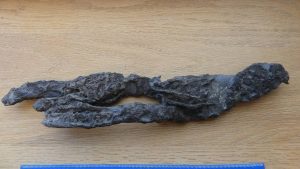
The remains of a 70-million-year-old carnivorous lobster have been found in Alabama, and the fossil is so well preserved it resembles well-cooked bacon. Not only are the large claws still attached — the biggest of which is 6.5 inches — but the creature also retained its delicate antennae, based on photos shared by the Alabama Museum of Natural History. “Looks like some beef jerky to me,” one commenter wrote on the museum’s Facebook page.
The 13.5-inch crustacean lived during the Late Cretaceous period and was known as Hoploparia, a genus that did not survive to the present day.
Its resemblance to anything tasty is misleading, according to Adiel A. Klompmaker, curator of paleontology with the Department of Museum Research and Collections and the Alabama Museum of Natural History. “This (appearance) is caused by the preservation of the fossil in the rock, giving it a mixture of brownish tints with some gray. Although it may look like beef jerky, my teeth would suffer greatly if I were to give it a bite here in my office. This lobster is literally rock-hard!” Klompmaker told McClatchy News. “I was amazed to see the antennae were preserved. … They really stand out from the rock.”
Visit the Miami Herald’s website for the full article.